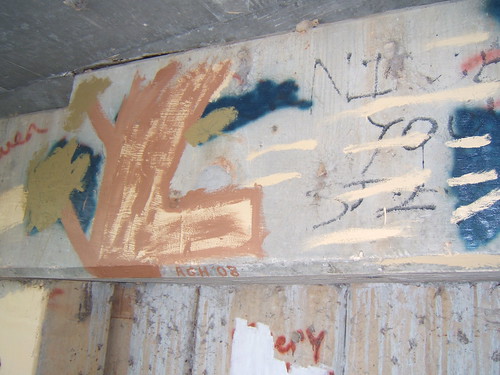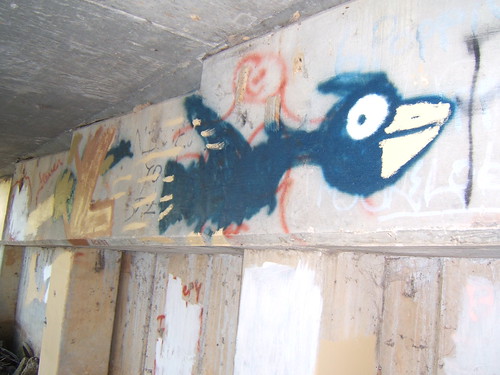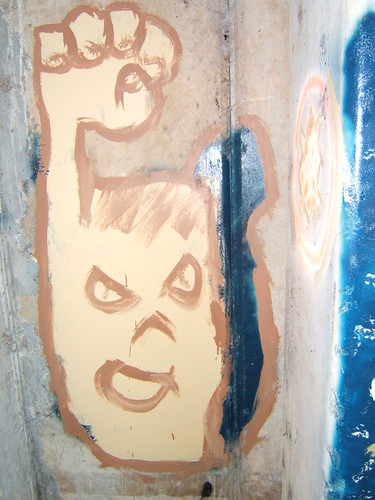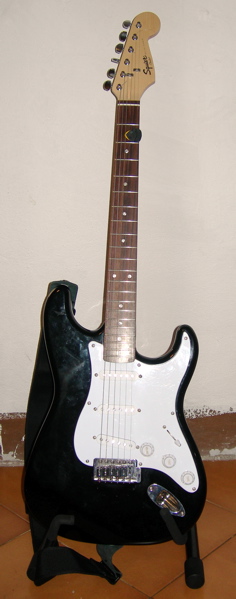About a year or so ago I read in
Make magazine about how

to make a guitar from basically a stick, some bolts, string, and a cigar box. I made one and it was a functional 3 string guitar, but it left a lot to be desired. It wouldn't hold tune, had no frets or fret markings, and didn't play very well for a number of other reasons. It did show me how easy making a stringed instrument
can be though, and taught me a lot about the fundamentals of guitars. Pictured here is the old cigar box guitar.
Fast forward to today and I've since
rebuilt one guitar from the wood up, rewired a couple, and generally learned more about them, and when I saw some nice cigar boxes for 50c a piece the other day I decided it was time to try my hand at making a better one. I got some parts first,

with the strings and tuning machines being the only things I had to get that were purpose-made for a guitar. The rest of the materials were a couple thin pieces of red oak (quickly becoming a favorite wood of mine), a length of poplar, some dollar-store stainless shish kabob skewers, and some other odds and ends.
I decided that I wanted this guitar to be made to a full scale, so I copied the bridge length and fret pattern off my strat-o-monster (another top secret project everyone I know knows about). I also wanted to have the fretboard above the body of the guitar as most normal guitars have, so I did a lot of eye-balling and a little measuring and wound up with a layout that uses a piece of red oak as a shim and another as the fretboard. I decided the neck would be much too thick for anyone short of an orangutan to play with those two and the poplar neck together, and the tuning machines needed the headstock area to be thinner, so I went to work rasping down the needed areas.
Rasping always seems like it won't be too bad before I start. "I'm just taking off 1cm of wood, it's not too bad." an hour and a half later I'd roughed out the shape of the neck and ensured my Popeye-like forearms won't be going anywh

ere soon. I glued most of the neck together and smoothed all the pieces together with my trusty surform rasp. I also cut a pair of notches for the neck to stick through the body with. With the neck glued together, it slides into the box and begins to look like a guitar. The neck is super-wide. It'll mostly be used for playing slide though, so no worries.
I had to drill out new string holes in the tuning machines since the stock ones sat very low on the pegs. I picked up the cheapest set of tuning machines I could find, which wound up being for a classical guitar. I just made sure to drill the holes perpendicular to the stock ones to keep from weakening the pegs. The ornate brass style of them matches the look of the box well though.
A few ideas I was entertaining but decided against: (1)Making it 3 string. There was too much fretboard and I had the tuning machines already. (2)Adding frets. That was the original purpose of the skewers and superglue, but since the neck is so wide and I got too impatient to make the notches in the fretboard I justify pushing on by telling myself this is something like an old blues guitar and the wide neck won't hurt playing slide.
Update 1:I tried to make do with a set of metal plates I had for the tail piece, but it didn't drop the

strings low enough for them to hold over the bridge, so I'll have to use some L brackets and shape a curve down the tail end to let the strings drop some. It'll look better like that anyway. I cut the bottoms out of both boxes and glued them together for more of an air chamber. I also filed out some groves for the nut and bridge bolts to sit in, glued the neck, tail piece, and top box lid together. I'll leave the bottom lid unglued until I figure out how I want to mount a pickup.
Update 2:
I got the guitar pla

yable yesterday, adding the stop piece and stringing it. I filed down the tail end to let the strings get some fall, then made a stop piece from galvanized steel and strung the guitar. It still needs to be sanded, stained, and clear coated on the body, but it's playable and sounds pretty nice. The stacked boxes give it more volume than just one, and it works pretty well for slide. A friend who plays guitar says that it has a similar sound to a 12 string when played with slide. It also has a weird sympathetic effect coming from the bridge over the tail, which is interesting and not loud enough to be more than just noticeable. Though the neck doesn't have a truss rod it hasn't taken very much bow either, which was something I was concerned with initially.
Update 3:
I've finished sanding and clear coating the CBG, and I've also added bamboo frets. I also added a piezo pickup and jack so the guitar can be amplified. The frets could still use some fine tuning since there are a few places where a couple frets are short enough to cause fret buzz, but the piezo comes through very clearly and the guitar sounds very nice. I'll fix the maligned frets when
I get a chance, but it's very playable as-is as evidenced by my buddy Daniel shows below.
There are more pictures of this guitar on
Flickr.
Update 4: Make: blog has
posted about my CBG, Thanks guys! I've also made another guitar. It's pretty much the same, but I cleaned up some of the rough edges and clear coated the boxes before putting it all together. I might make some more, who knows.



















